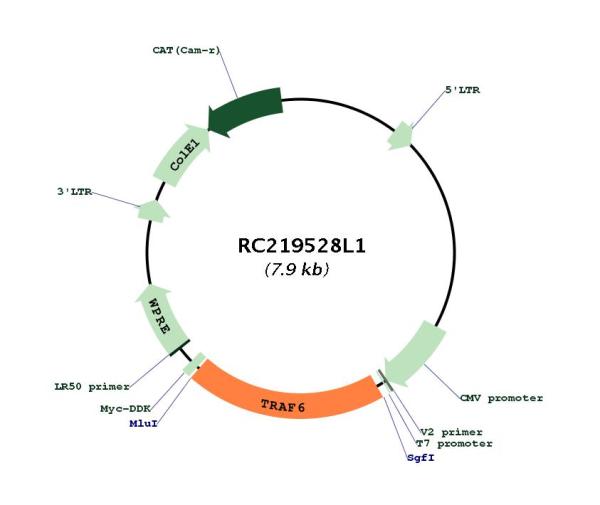TRAF6 (NM_004620) Human Tagged Lenti ORF Clone
CAT#: RC219528L1
- LentiORF®
Lenti ORF clone of Human TNF receptor-associated factor 6 (TRAF6), transcript variant 2, Myc-DDK-tagged
"NM_004620" in other vectors (6)
Specifications
| Product Data | |
| Type | Human Tagged ORF Clone |
| Tag | Myc-DDK |
| Symbol | TRAF6 |
| Synonyms | MGC:3310; RNF85 |
| Vector | pLenti-C-Myc-DDK |
| E. coli Selection | Chloramphenicol (34 ug/mL) |
| Mammalian Cell Selection | None |
| Sequence Data |
The ORF insert of this clone is exactly the same as(RC219528).
|
| Restriction Sites |
SgfI-MluI
Cloning Scheme for this gene
Plasmid Map

|
| ACCN | NM_004620 |
| ORF Size | 1566 bp |
| OTI Disclaimer | The molecular sequence of this clone aligns with the gene accession number as a point of reference only. However, individual transcript sequences of the same gene can differ through naturally occurring variations (e.g. polymorphisms), each with its own valid existence. This clone is substantially in agreement with the reference, but a complete review of all prevailing variants is recommended prior to use. More info |
| OTI Annotation | This clone was engineered to express the complete ORF with an expression tag. Expression varies depending on the nature of the gene. |
| Product Components | The ORF clone is ion-exchange column purified and shipped in a 2D barcoded Matrix tube containing 10ug of transfection-ready, dried plasmid DNA (reconstitute with 100 ul of water). |
| Reconstitution | 1. Centrifuge at 5,000xg for 5min. 2. Carefully open the tube and add 100ul of sterile water to dissolve the DNA. 3. Close the tube and incubate for 10 minutes at room temperature. 4. Briefly vortex the tube and then do a quick spin (less than 5000xg) to concentrate the liquid at the bottom. 5. Store the suspended plasmid at -20°C. The DNA is stable for at least one year from date of shipping when stored at -20°C. |
| Reference Data | |
| RefSeq | NM_004620.2 |
| RefSeq Size | 2515 bp |
| RefSeq ORF | 1569 bp |
| Locus ID | 7189 |
| UniProt ID | Q9Y4K3 |
| Cytogenetics | 11p12 |
| Domains | zf-TRAF, RING, MATH |
| Protein Families | Druggable Genome |
| Protein Pathways | Endocytosis, MAPK signaling pathway, Neurotrophin signaling pathway, NOD-like receptor signaling pathway, Pathways in cancer, RIG-I-like receptor signaling pathway, Small cell lung cancer, Toll-like receptor signaling pathway, Ubiquitin mediated proteolysis |
| MW | 59.4 kDa |
| Gene Summary | The protein encoded by this gene is a member of the TNF receptor associated factor (TRAF) protein family. TRAF proteins are associated with, and mediate signal transduction from, members of the TNF receptor superfamily. This protein mediates signaling from members of the TNF receptor superfamily as well as the Toll/IL-1 family. Signals from receptors such as CD40, TNFSF11/RANCE and IL-1 have been shown to be mediated by this protein. This protein also interacts with various protein kinases including IRAK1/IRAK, SRC and PKCzeta, which provides a link between distinct signaling pathways. This protein functions as a signal transducer in the NF-kappaB pathway that activates IkappaB kinase (IKK) in response to proinflammatory cytokines. The interaction of this protein with UBE2N/UBC13, and UBE2V1/UEV1A, which are ubiquitin conjugating enzymes catalyzing the formation of polyubiquitin chains, has been found to be required for IKK activation by this protein. This protein also interacts with the transforming growth factor (TGF) beta receptor complex and is required for Smad-independent activation of the JNK and p38 kinases. This protein has an amino terminal RING domain which is followed by four zinc-finger motifs, a central coiled-coil region and a highly conserved carboxyl terminal domain, known as the TRAF-C domain. Two alternatively spliced transcript variants, encoding an identical protein, have been reported. [provided by RefSeq, Feb 2012] |
Documents
| Product Manuals |
| FAQs |
| SDS |
Resources
Other Versions
| SKU | Description | Size | Price |
|---|---|---|---|
| RC219528 | TRAF6 (Myc-DDK-tagged)-Human TNF receptor-associated factor 6 (TRAF6), transcript variant 2 |
USD 486.00 |
|
| RC219528L2 | Lenti ORF clone of Human TNF receptor-associated factor 6 (TRAF6), transcript variant 2, mGFP tagged |
USD 786.00 |
|
| RC219528L3 | Lenti ORF clone of Human TNF receptor-associated factor 6 (TRAF6), transcript variant 2, Myc-DDK-tagged |
USD 786.00 |
|
| RC219528L4 | Lenti ORF clone of Human TNF receptor-associated factor 6 (TRAF6), transcript variant 2, mGFP tagged |
USD 786.00 |
|
| RG219528 | TRAF6 (tGFP-tagged) - Human TNF receptor-associated factor 6 (TRAF6), transcript variant 2 |
USD 686.00 |
|
| SC109844 | TRAF6 (untagged)-Human TNF receptor-associated factor 6 (TRAF6), transcript variant 2 |
USD 487.00 |
{0} Product Review(s)
Be the first one to submit a review






























































































































































































































































 Germany
Germany
 Japan
Japan
 United Kingdom
United Kingdom
 China
China



